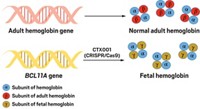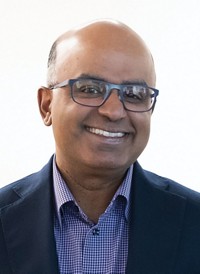As a child growing up in Monrovia, Liberia, Laura M. K. Dassama would run around and play sports with the neighborhood kids. But for some reason, she always seemed to tire out more quickly than her friends did. Her arms would hurt. Her legs would ache. She often lost her breath.

Credit: Ashleigh Reddy
Laura M. K. Dassama
Laura M. K. Dassama
Hometown: Monrovia, Liberia
Education: BS, Temple University, 2007; PhD, Pennsylvania State University, 2013
Current position: Professor of chemistry, Stanford University
Favorite lab tool: Pipettes, crystal microscope—I have too many; it’s hard to pick just one!
Best professional advice she’s received: Pick problems, not projects.
These episodes of exhaustion were sometimes so severe that she needed to be hospitalized and receive pain medication and blood transfusions. When she was about 5 years old, the doctors figured out why she was always running out of steam: sickle cell anemia.
Now a chemist at Stanford University, Dassama wants to use structural biology to help find potential therapies that could help treat sickle cell disease in people like her. In the US, about 100,000 people have the inherited disorder, according to the US Centers for Disease Control and Prevention (CDC). The disease is present in one of every 365 Black babies born in the US, and in sub-Saharan Africa, about 300,000 children are born with the illness every year, according to the US Department of Health and Human Services Office of Minority Health.
Sickle cell disease is caused by a mutation in the gene that codes for hemoglobin, the protein that carries oxygen in red blood cells. The mutation causes the blood cells to take on a crescent, sicklelike shape instead of the usual disk shape. These irregularly shaped cells can get stuck together in the body’s superhighway of arteries and veins, thwarting the flow of blood. As a result, people with the disease experience insufficient oxygen transport in their bodies, leading to fatal organ damage. Many people with sickle cell anemia die of it by the time they are 43, according to the CDC.
“For a long time, the goal was that it’s not going to ruin my life. I’m going to win at this,” says Dassama, who has had to limit her physical activity since childhood. “These are small battles every day in the big war, and eventually, I’m going to have to find a way to manage it.”
I’m living proof of what happens when you have increased levels of fetal hemoglobin.
In her quest to find potential treatments for sickle cell disease, Dassama is focusing on a protein called fetal hemoglobin, which is essentially unaffected by the mutation that causes the disease. This form of hemoglobin is most prevalent during fetal development, and its levels drop as people age. It binds to oxygen much more tightly than the adult version of hemoglobin does. For people with sickle cell disease, fetal hemoglobin can keep their red blood cells more oxygenated and prevent them from becoming sickle shaped.
People produce different amounts of the fetal version of hemoglobin. About 15% of the hemoglobin that Dassama produces is the fetal version, while her sister, who also has sickle cell disease, makes none. As a result, Dassama has had fewer medical emergencies related to sickle cell disease than her sister. At Stanford, Dassama is trying to design a molecule that can go to the bone marrow, where red blood cells are made, and increase levels of fetal hemoglobin by reactivating the gene that codes for it.
“I’m living proof of what happens when you have increased levels of fetal hemoglobin,” Dassama says. “It’s not a high barrier for us to be able to find a molecule that can allow us to turn on this fetal hemoglobin.”
Dassama’s current goal is to develop a molecule that increases fetal hemoglobin levels in the body from less than 1% to around 15%, which could potentially reduce the severity of sickle cell–induced bouts of pain and help people live healthier lives. Experts in the field hope Dassama’s and others’ research with small molecules could increase fetal hemoglobin levels by as much as 30%.
“That would be transformative. You would essentially make the disease’s symptoms completely go away,” says Stuart Orkin, a pediatric hematology-oncology researcher at Harvard Medical School whose lab Dassama worked in before coming to Stanford.
Though there are gene therapy approaches for sickle cell disease, those treatments are expensive and may not be as widely accessible. “If you had a pill for that and say you could distribute that widely, you could make this a nondisease,” Orkin says.
Scientists have already identified the protein, or transcription factor, that silences the fetal hemoglobin gene as we get older. Known as BCL11A, the transcription factor begins repressing fetal hemoglobin by the time a person is 1 year old. Dassama’s research is focused on finding ligands, such as small antibody fragments, that can inhibit BCL11A, degrade it, or change its function.
“Her work represents an attempt to bring new chemistry and structural biology to really focus in on a target for reactivating fetal hemoglobin,” Orkin says.
Mekedlawit Setegne, a graduate student in Dassama’s lab, said she was inspired to work with Dassama because of how she combined chemistry with a drive to make a change for others, especially Black Americans and Africans.
“I had always just assumed those two things had to be separate: you’re a scientist, you come and you do science, and then you go home and then think about the rest of the world,” Setegne says. But through working with Dassama, she learned she “can rigorously study something that has such an impact, and it’s OK to care about that impact.”
Chemical & Engineering News
ISSN 0009-2347
Copyright © 2024 American Chemical Society





Join the conversation
Contact the reporter
Submit a Letter to the Editor for publication
Engage with us on Twitter